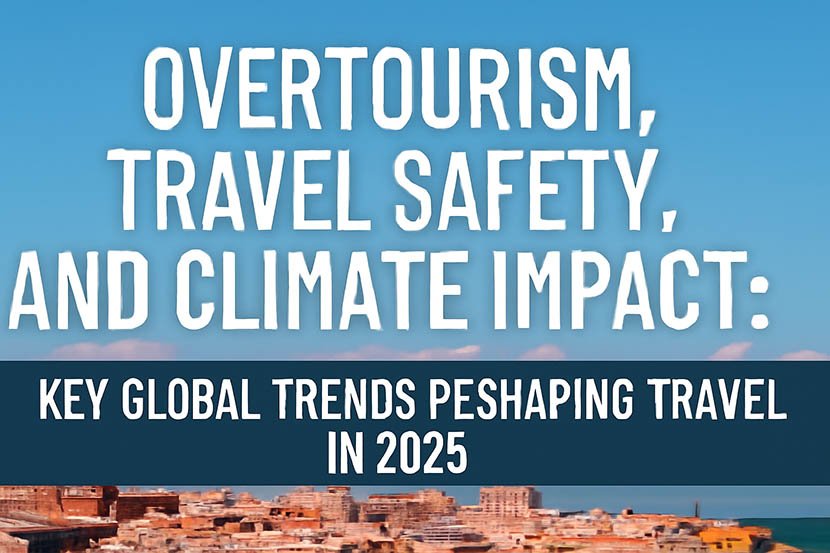Sunday, July 27, 2025
The tourism industry in 2025 is experiencing significant shifts, as cities around the world struggle to balance growth with sustainability and traveler safety. A new wave of regulations is emerging in response to overtourism, with high-profile destinations such as Venice and Barcelona leading the charge. Meanwhile, safety concerns are prompting travel advisories, and severe weather is causing major disruptions in aviation. As travelers continue to adapt to new realities, the impact of climate change on tourism becomes an increasingly pressing issue. Here’s a closer look at the global travel landscape in 2025.
Tourism Under Pressure: Overtourism and Its Global Impact
Overtourism is becoming one of the most pressing concerns in the global tourism industry. Popular destinations like Venice, Amsterdam, and Paris, once the crown jewels of European travel, are now leading efforts to curb excessive tourism and its negative effects on local communities and cultural heritage. Following in their footsteps, cities like Mexico, Japan, the U.S., and Indonesia are implementing new measures to regulate tourist flow.
Mexico, for instance, has introduced cruise restrictions in Hawaii, while iconic locations such as Machu Picchu in Peru and the historic districts of Kyoto in Japan are now imposing strict visitor limits. These measures aim to protect the environment and preserve cultural landmarks for future generations.
In addition to limiting tourism flow, several cities are introducing higher tourist taxes to help fund sustainability initiatives. Barcelona, for example, has raised its tourist tax, with plans to increase it to €8 by 2029. This trend is also visible in cities such as Rome, Paris, New York, and Montreal, where taxes are being adjusted to address the environmental impact of tourism and to fund local infrastructure projects.
Safety and Security: Travelers Navigate High-Risk Zones
While some destinations are focusing on managing tourist numbers, others are grappling with safety concerns, particularly in high-risk zones. In Mexico’s Tamaulipas state, the U.S. State Department has issued a “Do Not Travel” advisory due to ongoing cartel violence, including kidnappings and extortion. Local authorities have attempted to mitigate risks by increasing police presence, but conflicting messages from officials have left travelers confused and cautious about venturing into the region.
The U.S. government continues to monitor the situation closely, with the safety of tourists being a key concern for the broader region. While the U.S. is not the only country facing safety issues, this serves as a reminder of the risks that can emerge in certain parts of the world. Travelers are encouraged to stay informed about safety advisories before planning their trips to high-risk regions.
U.S. Aviation: Weather Disruptions and Airline Competition
In the United States, severe weather events are wreaking havoc on aviation schedules. Thunderstorms, flash floods, and high winds have led to the grounding of more than 250 flights across major airports, including Chicago O’Hare, JFK, and LaGuardia. Airlines such as Southwest, Delta, United, and JetBlue have been particularly affected by these weather disruptions, with additional delays expected as the storm system moves eastward.
Beyond the weather, the U.S. airline industry is also seeing shifts in passenger preferences. Legacy carriers like Delta and American Airlines continue to dominate, but low-cost airlines such as Allegiant, Sun Country, and Spirit are rapidly gaining market share. This growing trend towards budget travel reflects a post-pandemic shift in consumer behavior, with more travelers opting for affordable flights and fewer frills.
Canada’s Tourism Decline and the Shifting Travel Patterns
While some destinations are thriving, others are seeing significant downturns in tourism. Canada’s inbound tourism has dropped sharply in 2025, particularly from the U.S., UK, France, Germany, and Australia. Geopolitical tensions and changing travel habits are contributing factors to this decline, with many international travelers opting for alternative destinations.
At the same time, Canadian travelers are showing a preference for domestic vacations over international trips, particularly to the U.S. High travel costs and political polarization in the U.S. are pushing Canadians to explore their own country, with campaigns like “Canada Strong” promoting local tourism. This trend is part of a larger movement towards staying closer to home in response to economic and political uncertainties.
Climate Impacts on Travel: Extreme Heat Waves and Disruptions
As climate change accelerates, its impact on travel is becoming increasingly evident. The U.S. Gulf Coast and southeastern cities are currently experiencing a dangerous heatwave, with triple-digit temperatures and high humidity levels. Cities like Atlanta, New York, and Boston are under heat advisories, with health warnings urging travelers to stay indoors and avoid outdoor activities.
The extreme weather has also caused cancellations of outdoor events, further illustrating how climate change is disrupting travel plans. With global temperatures continuing to rise, it’s likely that more destinations will face similar challenges in the future, forcing travelers to rethink their summer vacation plans and consider alternatives to traditionally hot spots.
The Way Forward: Adaptation in a Changing World
As the tourism industry evolves in response to these challenges, there is a growing need for adaptation and resilience. Destination managers are increasingly focusing on sustainable tourism practices that balance the needs of travelers with the protection of local communities and the environment. Safety advisories are prompting tourists to be more cautious when choosing destinations, and extreme weather is reshaping travel patterns, especially in regions vulnerable to climate change.
The future of global travel will likely be defined by these challenges, with an emphasis on sustainability, safety, and climate adaptation. Travelers and industry leaders alike will need to stay informed and flexible as they navigate this ever-changing landscape.
